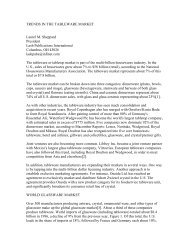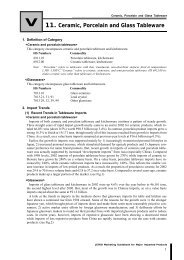Appendices to CBI Export Planner - crecer
Appendices to CBI Export Planner - crecer
Appendices to CBI Export Planner - crecer
You also want an ePaper? Increase the reach of your titles
YUMPU automatically turns print PDFs into web optimized ePapers that Google loves.
<strong>CBI</strong> <strong>Export</strong> <strong>Planner</strong>Finalizing the <strong>Export</strong> AuditThe (Company) <strong>Export</strong> Audit usually takes several weeks, sometimes even months <strong>to</strong>complete. Collecting the information takes time, since you have <strong>to</strong> depend on outsidesources which do not always work as fast as you do. However, the final analysis does nothave <strong>to</strong> take long.After the Project Manager has provided the management with all the necessary data,evaluating the outcome is a matter of days. The Project Manager should prepare theevaluation, combined with his views whether or not exporting would be within thecompany’s capabilities. Top-management should discuss the results with him and withthe researchers involved.Basically, the analysis should show how corporate assets (or ‘Strengths’) could beexploited in the market’s Opportunities. If the analysis has shown corporate Weaknesses,look for a method <strong>to</strong> solve these weaknesses, leading you <strong>to</strong> the Threats in the market.For easy identification you could list them in four squares, separated by a large cross, e.g.like this:Figure 2.4.2SWOT analysisStrengths:• well-trained staff• ample production capacityOpportunities:• growing market demand• novelty-mindedWeaknesses:• weak financial structure• no export experienceThreats:• strong local competition• import tax highAs you can see, the <strong>Export</strong> Audit has provided the Strengths and Weaknesses data fromthe analysis of Corporate Resources, whilst the Opportunities and Threats can be foundin the Instrumental Resources analysis.In this simplified example a typical ‘newcomer’ is attracted by a growing, possibly trendconsciousmarket. But so are others, local competi<strong>to</strong>rs, which have the advantage ofbeing more familiar with the market. If the import tax will be <strong>to</strong>o high, the prospectiveexporter will not have the financial means - nor the know-how - <strong>to</strong> fight his way in. If, atthe other hand, the product is indeed a novelty for the target market, the chances are thata local importer, recognising its merits, will help the exporter (with know-how and evenmoney) <strong>to</strong> gain market entry. Your final analysis would recommend “No” in the first case,“Yes” in the second. In any case the lack of money is always a formidable barrier.In this stage you may want <strong>to</strong> involve others, particularly key-people in yourorganisation. An (internal or external) marketing expert’s advice will prove <strong>to</strong> be veryvaluable. The final analysis can be prepared jointly.The environmental assessmentThere is one important area left which you may want <strong>to</strong> include in your initial analysis -either at this stage or earlier - at the third step of your assessment of InstrumentalResources. It relates <strong>to</strong> the natural environment.26 II - The exporting company





